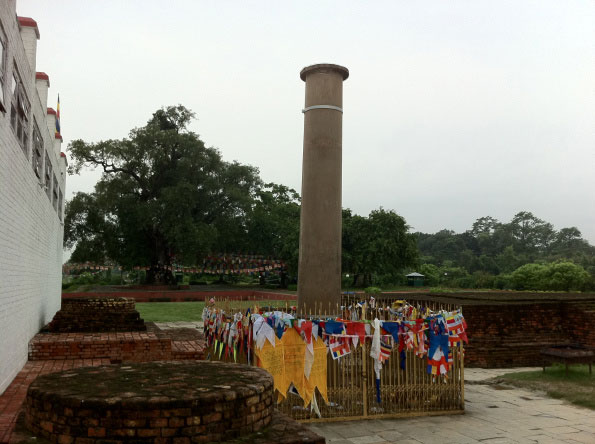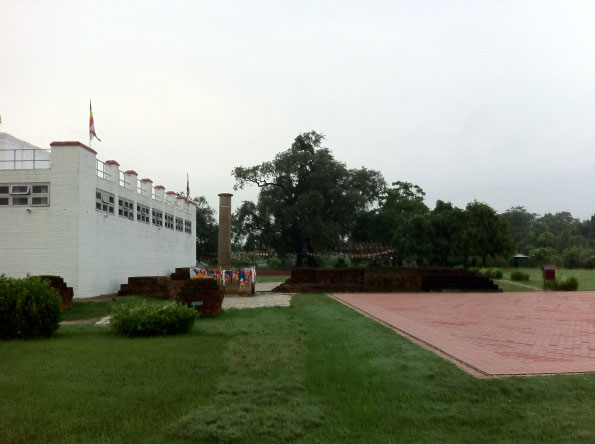Pre-Ashokan Buddhist monuments discovered In Lumbini
Unearthed Pre-Ashokan Buddhist Structures
Pushed The History Lumbini By 1000 Years
Kathmandu: New excavations in Lumbini, the birthplace of Lord Buddha, have unearthed ruins of a pre-Ashokan Buddhist temple of brick and a village suggesting that Buddhist activities in the area were in full swing 1,000 years before Emperor Ashoka of Mauriya dynasty of India visited the holy place in 249 BC.
The finding of the startling archaeological evidences in Lumbini in south-west Nepal has not only pushed the history of the holy place back by over 1,000 years, but also proved the presence of Karkuchhanda, Kanakamani and Kasyapa Buddhas, popularly known as human Buddhas, before the birth of Lord Budda in 567 BC. Both Hinayana and Mahayana sects of Buddhism believe that Shakyamuni Buddha (Lord Buddha) was preceded by human Buddhas Karkuchhanda, Kanakamuni and Kasyapa.
A team led by Prof Coningham of Durham University in UK and consisting of Nepali and international experts discovered these pre-Ashokan evidences for the first time in entire South Asia in June this year. Experts claim no remains of human settlements as old as these were traced in Terai of Nepal and in northern India. The finding has pleased many Nepalese archaeologists and others who were unable to counter the powerful Indian media spreading the misleading information around the globe that Lumbini lies in India.
“For the first time in South Asia, excavations have revealed a pre-Ashokan brick temple built over a wooden structure,”
Coningham said at a press conference in Kathmandu organised to inform the press about the new finding in the first week of July.
The excavation programme that began in 2010 by UNESCO was funded by Japan government. In three years, the project had succeeded to trace a village like settlement 4.5 metres underneath the ground some 200 metres south of the Maya Devi temple. The findings give a picture of human settlements and cultures different from the time of hunting and gathering.
Until now, the Ashokan pillar erected by Emperor Ashoka and the brick temple of Maya Devi, also built by Ashoka in 249 BC, were believed to be the oldest Buddhist monuments in the area.
Emperor Ashoka had paid homage to Lumbini on the occasion of the 20th year of his coronation and erected the pillar in the exact birthplace of Lord Buddha, which still stands.
Even the Ashoka pillar and the Mayadevi temple were explored by General Khadga Shumsher and German archaeologist Dr. Fuhrer only in 1896 buried under a dense forest. The discovery of this pillar had ended all speculations about the location of Lumbini. The Emperor had inscribed in Sanskrit, “Hitajayete Buddha” (Buddha was exactly born here) on the pillar.
The emperor had also erected two other pillars during his visit to Lumbini and Kapilvastu, one in Gotihawa, the place of Krakuchhanda Buddha, and another at Niglihawa, the place of Kanakmuni Buddha. The Gothihawa pillar is now in broken condition and the Niglihawa pillar is lying on the ground. The archaeologists have not found the missing upper part of the broken Gotihawa pillar.
The inscriptions on the Ashok pillar suggested that the pillar and the temple remained unknown for almost 584 years as the last inscription was of Ripu Malla, an influential Khasa dynasty king of present day Karnali area in Western Nepal.
In the press conference, Coningham further said that even older remains of a village dating back to as early as 1300 BC were found a few hundred metres south of Lord Buddha’s birthplace, pushing the date of the settlements of the region back by a thousand years.
The Nepali officials have termed the two findings (brick temple and human settlements in Lumbini) as giant steps and committed to preserve them well.
“These discoveries help us to better understand the origins of Lord Buddha’s life and the spiritual importance of Lumbini,” said vice-chairman of Lumbini Development Trust Acharya Karma Sango Sherpa.
Local media in Kathmandu published the new findings in Lumbini giving much priority.
Similarly secretary at the Ministry of Culture and Tourism Sushil Ghimire said,” We have now every robust proof that Lumbini’s history extends far before the visit of Emperor Ashoka. The government of Nepal will step up its efforts to preserve the outstanding universal value of the holy site.”
The excavation team worked within the framework of a UNESCO project.
Sherpa claimed said that the findings proved that human Buddhas, Krakuchchhanda Buddha and Kanakmuni Buddha conducted religious activities prior to birth of Lord Buddha.
Lumbini, the UNESCO World Heritage site, lies in southern Nepal, near Nepal-India border. However, a section of Indian media and intellectuals have been misleading the world claiming that Lumbini is in India. The latest discovery is widely expected to be a fitting answer to the misleading ploy.
According to literary sources, Chinese pilgrims Fa-hien and Hiuen Tsiang had visited Lumbini in 403 and 636 AD respectively. The accounts of these two Chinese pilgrims suggested the site and had inspired Alexander Cunningham to initiate exploration of Buddhist sites of Indian sub continent in 1870s. But as Nepal was closed then, he was unable to carry any excavation.
Further excavation by Indian archaeologist Babu Purna Chandra Mukherjee in 1899 and the finding of the Nativity sculpture (image of Maya Devi) confirmed that Prince Siddhartha was born in Lumbini, Nepal.
Besides Lumbini, the archaeologists had recovered the palace, including its western and southern gates including the fortified walls of Shakya king Suddhodhana, father of Lord Buddha, in Tilaurakot, and Kudana where Lord Buddha remained a few weeks and met his father after His enlightenment and other places directly linked with the life of Lord Buddha. Excavation works in Kapilvastu is still going on. Interestingly, the findings in Kapilavastu, Nigliwahawa, Kudan and Gotihawa exactly matched with the descriptions of the Chinese monks Fa-hsien and Hiuen Tsiang.
Interestingly, all these Buddhist sites can be visited in one go. Any visitor can reach Lumbini from flights or buses from Kathmandu. The Lumbini Master Plan designed by Prof Kenzo Tange and approved by the Nepal government and the UN was yet to be fully implemented although it should have completed by 1995. However, any visitor can accommodate in the temples of their respective country built in Lumbini under the Master Plan. Korean, Chinese, Thai and other several nations have built their temples/hostels in the premises of Lumbini reflecting their own cultures.










































































